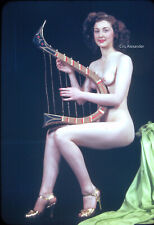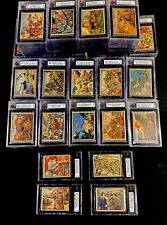13- 1938 Cris Alexander Broadway showgirls | USA Obscenity | 35mm Kodachrome WW2

When you click on links to various merchants on this site and make a purchase, this can result in this site earning a commission. Affiliate programs and affiliations include, but are not limited to, the eBay Partner Network.
13- 1938 Cris Alexander Broadway showgirls | USA Obscenity | 35mm Kodachrome WW2:
$44400.00
Original 1/1 discovery with rare history in Kodak photography.
This is a barnyard estate discovery of 13 slides estimated from 1938-1941 photographed by Cris Alexander during the USA Obscenity law not protected by the first amendment. These are original 1/1 35mm Kodachrome images that were not discovered until after his death in 2012. This find is similar to of Alfred Chaney Johnston after his death in 1971 of Ziegfeld Follies Showgirls (black & white).
The Photographer: Cris Alexander was born in 1920, a young radio announcer and moved to New York City to open a photo studio in late 1930s. During this transition Cris was a Broadway actor and was noted to be close friends with biggest Hollywood stars of this generation. He later went into magazine photography and then worked with Andy Warhol as chief Photographer for his Interview magazine. Cris was not known to sell his photos as art, thus not recorded in big art galleries. A few of his peers from this generation (black and white) has sold originals of nude photography art in the 6-7 USD figure.The Models: The style of photography and costume represents the 1930s-40s. The indoor studio shots with shoes are seen in New York Broadway performances and 1940s MGM Ziegfeld Follies. It is highly likely these models are from theater and broadway performance that worked along side with Cris.
Carmen Miranda: The 7th image is estimated to be taken in early 1938 based on the camera technology, a year prior to Hollywood Stardom for Carmen Miranda. The 16th photo shows 3 images, 2 images selected close to the 1938 era for best comparison. The 2 images selected were studio portrait headshots while the 35mm slide image was zoomed in to compare facial features. All 3 images have different facial expressions, camera angles, and loss of detail in some areas. The 17th image compares signature markings penciled in to focus on. The circled eye shows double eye lid structure, eye shape, eye bags lines all matching. The 4th tooth on right is missing in both images. The neck crease is circled to show similar location. The 18th photo shows the 2 images comparing the 2nd and 3rd tooth on right, all matching. Also note the image on left and right of 18th photo, the right 2nd tooth shape are different, indicating this period Carmen was in phase of getting her teeth worked on. The left image that shows the 4th tooth repaired also shows the 2nd tooth shaven down from the right image. The 19th image was zoomed in to compare from a early 1930s photo when Carmen was in South America. The comparison images are used to examine facial features and not included in this lot.
Film Technology: Kodachrome was first released in 1935 as new technology with a 28 stage process only developed in USA exclusive until 1954 at the Kodak Lab. Huge color advancements were made in mid 1938 which led to a change in red border slide distinction in 1939. In this collection you can see 4 slides with faded color and the rest in true color. Those 4 slides were taken prior to the Kodachrome color advancement in 1938 which shows Cris Alexander camera gear transition period. The SVE slide binders are sold in the aftermarket with glass covers for higher protection. The SVE are seen used from the 1930s-50s. Kodachrome has a geometric marking on the edge of the film but it was not consistent in early years. The slide are kept in original condition, in order to see if there is a coded marking on the SVE years, it would have to be broken apart.
The Rarity: All the slides in this lot were purchased from an vintage re-seller. The re-seller stated they had acquired it from the family estate sale. Color nude film was illegal in America up until 1952, which made it difficult to develop nude photos in the early years of Kodachrome. It was later discovered from another estate sale, GEM photo studio was processing nude Kodachrome during the US Obscenity law in New York. The indication of an original Kodachrome is without a serial number (duplicate), non orange border (duplicate), or a distribution label. One red border slide is marked with C. Alexander 1941 copyright, the other red border is hand written AX for Alexander initials. The blue border slide was released from 1935-1938, these first generation slide did not have a Kodak or Kodachrome label, just Made in the USA. The estimation of years are collected from the camera technology, blue and red border years, the studio / outdoor similar settings, age of Cris Alexander moving to NYC, and the models outfit.
The Reproduction: A few of these models are seen in other nude collections from various commercial distributors. Some of those slides are in unmarked slide binders with lower grade Ansco quality reproductions from the 1950s. There is a possibly a portion of this collection was sold to a distributor in the 1950s. The distributor then takes the original Kodachrome and duplicates it, giving a lower resolution picture of picture quality. There are also a few postcards that are seen with these models but not exact poses.
The History: In May 1952, the Supreme Court overturned itsMutualdecision inJoseph Burstyn, Inc v. Wilson, popularly known as the "Miracle Decision".Color Nude film was considered obscene until 1952 and not covered under the first amendment. In 1953 Playboy released its first issue, in this era the market was flooded with commercial slides. Black and White nude photography was also restricted in the 1930s, commercial sales and distribution were not allowed to show full nudity with full facial features or vice versa. This example can be seen with the likes of Edward Weston. Europe did not have these restrictions, commercial prints emerged mostly from London and Paris. The example with likes of John Everard, they had the advantage of using Afgachrome which came out with color in 1932 and improved to new color in 1936. There were some loopholes used in USA from the 1930s to 1940s with pictorial art, a form of turning a photo into a hand drawn illustration appearance as art. This Pin-up example can be seen with the likes of Earl Moran. During WW2 Afgachrome production was seized in America due to German ownership.
The Condition: The slides are kept in original condition and has not been cleaned. There are trapped particles in between the glass which can be cleaned up if you chose to do so. The slides are scanned with a low grade kodak scanner, the quality can improve with a high end drum scanner. The watermark was added and not on the actual film.
Please inquire for best method of shipping/insurance to your location prior to offer.
13- 1938 Cris Alexander Broadway showgirls | USA Obscenity | 35mm Kodachrome WW2:
$44400.00

Related Items:
13- 1938 Cris Alexander Broadway showgirls | USA Obscenity | 35mm Kodachrome WW2
$44400.00
1938 HORRORS OF WAR GUM INC. COMPLETE CARD SET (288) ALL KSA GRADED
$13129.80
HORRORS OF WAR CARDS COMPLETE SET (288 CARDS IN ALL)
$11500.00







